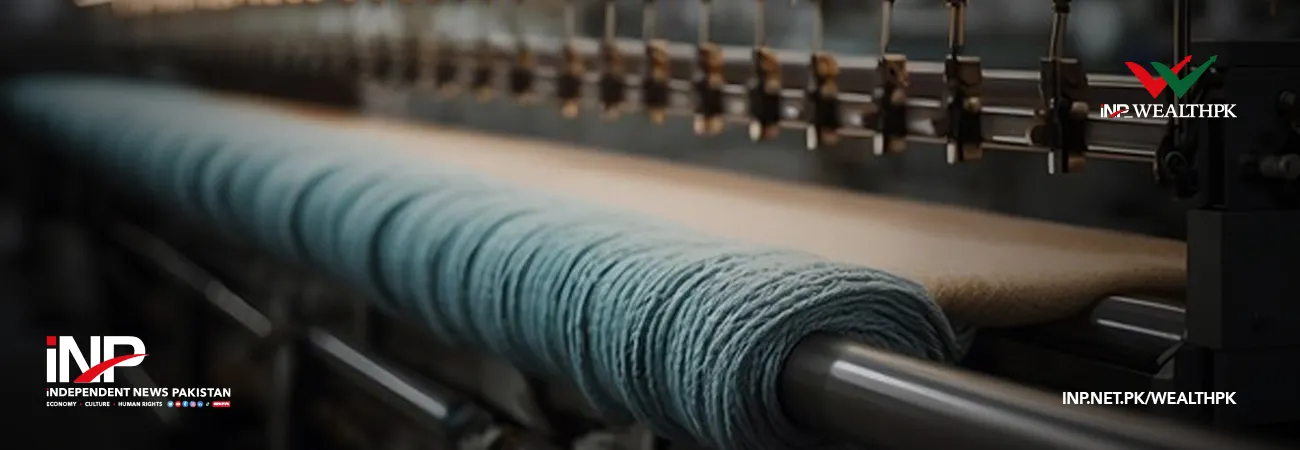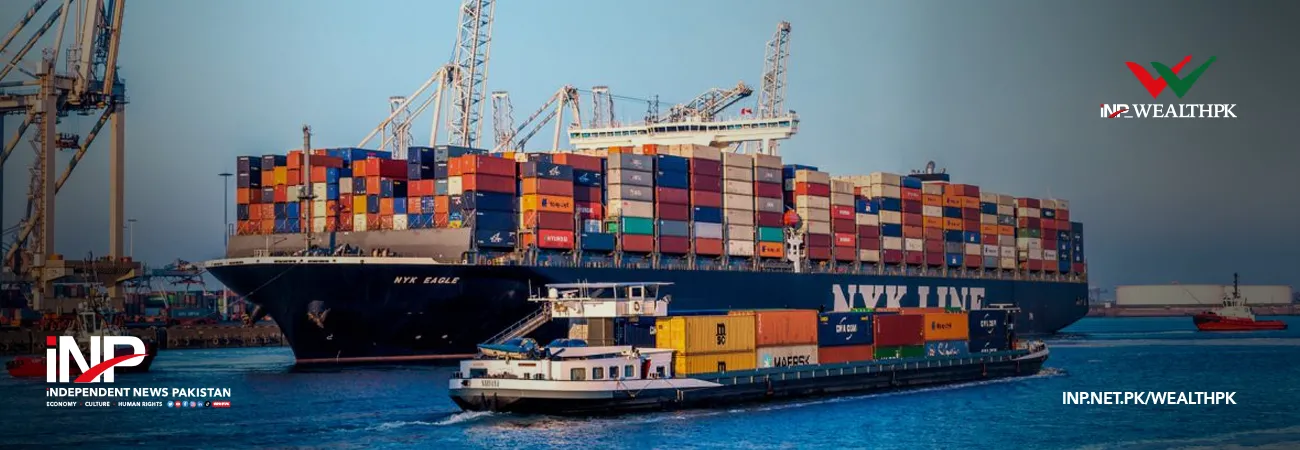INP-WealthPk
By Qudsia Bano
ISLAMABAD, Oct 28 (INP-WealthPK): Pakistan is the world's fourth-largest cotton grower and a major player in the global textile industry. Its knitwear industry is the country's top value-added textile sector, characterized by outstanding raw material quality and competitive end-product value.
In the second half of the fiscal year 2020-21, Pakistan's textile exports climbed by 7.7 percent, with knitted garments and hosiery taking the lead over the same period last year. The country's textile exports in July-December (2020-21) were USD7.4 billion, up 7.7 percent from USD6.9 billion in the same period of 2019-20, according to data shared by the Pakistan Bureau of Statistics (PBS).
 (https://www.pbs.gov.pk/sites/default/files//external_trade/monthly_external_trade/2021/April-2021/release_statement_march_2021.pdf)
Knitwear (Rs48,974 million), readymade garments (Rs40,088 million), bedwear (Rs36,726 million), and cotton cloth (Rs36,726 million) were the top export commodities in March 2021.
Pakistan currently has 3,500 large, medium, and small hosiery and knitwear facilities, with 85 percent being small businesses, 10 percent medium businesses, and only 5 percent completely integrated companies. There are 13,372 circular knitting machines, 10,646 flat knitting machines, and 23,241 socks knitting machines around the country. This sector's capacity utilization is around 70 percent, and in addition to locally built machinery, liberal imports of machinery under various modalities and increased capacity would boost exports.
Since 2015-2016, the knitted garment sector has ranked the first within the textile group for the last three years. Knitwear (hosiery) exports remained at the top of the textile export chain as well as total national exports, with a 16 percent growth in the fiscal year 2017-18 compared to 2016-2017.
Because of the increased versatility of knitting techniques, the adaptability of many new handmade fibers, and the growth in consumer demand for wrinkle-resistant, stretchable, snug-fitted garments, knit goods have become extremely popular in recent years, particularly in the rapidly expanding areas of sportswear and other casual-wear garments.
Despite being under pressure from competitors such as Bangladesh, India, and the Far East, this sector offers export potential. However, the achievement was impressive because the industry worked hard despite inconsistent power supplies and labor turmoil, which frequently caused production to be temporarily stopped.
PBS recently released data for the first four months of the current fiscal year, confirming that textile and garment export shipments are back on track, both in terms of quantity and dollar value. To help exporters recover from the Covid-19 shock, the government recently provided a lucrative energy package for the business. The package eliminates peak electricity prices, lowers tariffs for increased power consumption, and sets the price of power at USD0.07 per unit and the price of gas at USD0.065/mmbtu for the export sector.
Aside from domestically developed machinery, liberal imports of machinery in various ways are also made, with expanding capacity based on exports generated over time. Knitting machinery, particularly circular and flat machinery, is predominantly imported from Europe, Japan, and China. This industry is very easy to invest in such equipment because of the little investment required, and some of the machines and parts are also manufactured locally.
Pakistan is also facing certain challenges in this industry. Small businesses face greater problems because they lack access to electricity and funding. In several categories, overseas buyers were gravitating towards our competitors. On the one side, Pakistani exporters were losing revenue, while on the other, they were losing reputation owing to the non-fulfillment of export commitments in overseas markets as a result of load shedding and rising input costs. Pakistan is looking into new prospective markets at various locations to boost its exports. The government has made increasing the country's exports and meeting trade targets for the current fiscal year a primary priority. For many years, the economy's major textile industry has been in a state of decline. As a result, significant textile capacity had been harmed, and textile exports had dropped across the value chain, both in quantity and value terms, whereas regional peers had doubled their exports. Export competitiveness is the most important requirement for achieving significant growth. Low productivity, inadequate human resource training, inadequate infrastructure, low value-added items, low sophistication, lack of technology, and essentially no value chain integration are among the weaknesses. Reduced input costs, such as energy, gas, and water tariffs, are the long-term solution.
An export package was recently authorized by the Cabinet's Economic Coordination Committee (ECC) to increase the country's dwindling exports. Under the package, eligible textile and non-textile exporters will receive 50 percent of the incentive on the same terms. The chief coordinator of the Pakistan Hosiery Manufacturers Association urged the government to form a task force, particularly at a time when China's garment sector, which accounts for more than 30 percent of the global apparel market, is relocating. A regional group is needed to identify difficulties that the industry is facing and then provide solutions to ensure its viability and competitiveness in the worldwide market. The garment sector requires less capital, creates four times the number of employments for the same investment, consumes less energy, and adds more value.
(https://www.pbs.gov.pk/sites/default/files//external_trade/monthly_external_trade/2021/April-2021/release_statement_march_2021.pdf)
Knitwear (Rs48,974 million), readymade garments (Rs40,088 million), bedwear (Rs36,726 million), and cotton cloth (Rs36,726 million) were the top export commodities in March 2021.
Pakistan currently has 3,500 large, medium, and small hosiery and knitwear facilities, with 85 percent being small businesses, 10 percent medium businesses, and only 5 percent completely integrated companies. There are 13,372 circular knitting machines, 10,646 flat knitting machines, and 23,241 socks knitting machines around the country. This sector's capacity utilization is around 70 percent, and in addition to locally built machinery, liberal imports of machinery under various modalities and increased capacity would boost exports.
Since 2015-2016, the knitted garment sector has ranked the first within the textile group for the last three years. Knitwear (hosiery) exports remained at the top of the textile export chain as well as total national exports, with a 16 percent growth in the fiscal year 2017-18 compared to 2016-2017.
Because of the increased versatility of knitting techniques, the adaptability of many new handmade fibers, and the growth in consumer demand for wrinkle-resistant, stretchable, snug-fitted garments, knit goods have become extremely popular in recent years, particularly in the rapidly expanding areas of sportswear and other casual-wear garments.
Despite being under pressure from competitors such as Bangladesh, India, and the Far East, this sector offers export potential. However, the achievement was impressive because the industry worked hard despite inconsistent power supplies and labor turmoil, which frequently caused production to be temporarily stopped.
PBS recently released data for the first four months of the current fiscal year, confirming that textile and garment export shipments are back on track, both in terms of quantity and dollar value. To help exporters recover from the Covid-19 shock, the government recently provided a lucrative energy package for the business. The package eliminates peak electricity prices, lowers tariffs for increased power consumption, and sets the price of power at USD0.07 per unit and the price of gas at USD0.065/mmbtu for the export sector.
Aside from domestically developed machinery, liberal imports of machinery in various ways are also made, with expanding capacity based on exports generated over time. Knitting machinery, particularly circular and flat machinery, is predominantly imported from Europe, Japan, and China. This industry is very easy to invest in such equipment because of the little investment required, and some of the machines and parts are also manufactured locally.
Pakistan is also facing certain challenges in this industry. Small businesses face greater problems because they lack access to electricity and funding. In several categories, overseas buyers were gravitating towards our competitors. On the one side, Pakistani exporters were losing revenue, while on the other, they were losing reputation owing to the non-fulfillment of export commitments in overseas markets as a result of load shedding and rising input costs. Pakistan is looking into new prospective markets at various locations to boost its exports. The government has made increasing the country's exports and meeting trade targets for the current fiscal year a primary priority. For many years, the economy's major textile industry has been in a state of decline. As a result, significant textile capacity had been harmed, and textile exports had dropped across the value chain, both in quantity and value terms, whereas regional peers had doubled their exports. Export competitiveness is the most important requirement for achieving significant growth. Low productivity, inadequate human resource training, inadequate infrastructure, low value-added items, low sophistication, lack of technology, and essentially no value chain integration are among the weaknesses. Reduced input costs, such as energy, gas, and water tariffs, are the long-term solution.
An export package was recently authorized by the Cabinet's Economic Coordination Committee (ECC) to increase the country's dwindling exports. Under the package, eligible textile and non-textile exporters will receive 50 percent of the incentive on the same terms. The chief coordinator of the Pakistan Hosiery Manufacturers Association urged the government to form a task force, particularly at a time when China's garment sector, which accounts for more than 30 percent of the global apparel market, is relocating. A regional group is needed to identify difficulties that the industry is facing and then provide solutions to ensure its viability and competitiveness in the worldwide market. The garment sector requires less capital, creates four times the number of employments for the same investment, consumes less energy, and adds more value.











